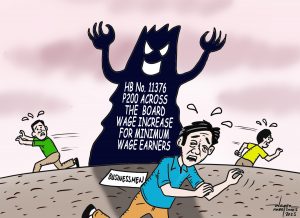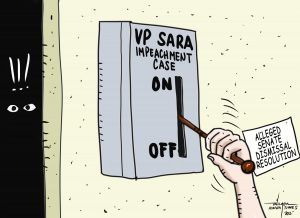I was wonderfully surprised to meet so many Davaoeño inventors in one place at the same time last Thursday, May 9, for a consultation workshop to create a road map for the newly-created Davao City Inventions and Innovations Center (DCIIC).
There were around 30 of them and it delighted me to see some female inventors joining the predominantly male group. They were all members of the Davao Inventors Association (DIA) led by President Virgilio M. Sangutan.
One inventor confided in me that he long gave up attending meetings called by either the national or local government because it was all talk but no follow through action. Nothing concrete that directly responded to what our local inventors needed.
When I asked him why he chose to show up this time, he said: “Because there is finally an ordinance for inventions and inventors. I want to make sure we have a voice and a part in implementing it.”
Councilor Pilar C. Braga, fondly called by DIA as “the godmother of Davao inventors,” made sure they are included in the ordinance she crafted and in its actual implementation that is why she gathered all of them last Thursday.
The consultation workshop had a “mad scientist” vibe to it and I had so much fun just absorbing their creative energies.
When the inventors gathered where asked what innovation is for them, their answer was unanimous: “It must be local, unique, useful, and benefits all.”
When asked what their model of an innovative city is, the majority answered Davao City.
They are not just being loyal citizens loving their own city. And it is also not because they have not seen other cities in the country and in the world. As inventors, they consider Davao innovative because of the abundance of natural resources and materials and the vast physical space for development. It is also because of the presence of creative talents who cooperate with rather than compete against each other.
However, I am sad to report that they believe our city’s inventions and innovations rarely had anything to do with government.
All of our local inventors proudly (and a bit grudgingly) declared that most of the inventions and innovations in Davao City are “80 percent sariling sikap” (self-help). The other 20 percent they attributed to our natural resources and networking with other inventors and innovators.
No wonder our local inventors shy away from government-organized events and meetings. As one senior inventor lamented, “If there’s fake news, there’s also false hopes.”
We keep saying inventors are important to our growth and development but we do not take them seriously enough to respond to their actual needs.
Madeleine Key, who covers invention commercialization and the innovation ecosystem for Forbes Magazine, wrote that inventors do not receive the respect they deserve.
“A curiosity of the innovation ecosystem is that while inventors are celebrated for their uniquely important contributions, they’re also underrepresented,” Key noted.
She reported that inventors are rarely speakers at conferences about intellectual property and technology. They do not hold leadership positions at the government patent and trademark offices. When you search the Internet for inventors, nearly all of the images are old and from the past.
During the consultation, I got a glimpse of the challenges our local inventors face.
One inventor shared that it was difficult for him to get his invention off the ground due to lack of equipment to build a new prototype. Local fabricators would often tell our local inventors that their products are “too complicated and difficult” to make.
That is why they dream of having a manufacturing complex with all the different machines, tools, and equipment they need to create new products that can solve different problems and respond to various needs. They think it is something that the government should seriously invest in and it can be a source of revenue for the government, too, because the inventors are willing to pay to rent the facilities.
Another challenge they shared is the expensive and unrealistic regulatory and testing fees imposed by the government to get their products approved. This is especially a problem being faced by those in the field of food and health.
Speaking of regulatory-related obstacles, our inventors, who are also entrepreneurs, complained about the “exasperating red tape” in national and local agencies.
“We feel unsupported and unserved by the lack of willingness of government agencies to solve complex problems and to find ways to help unique situations entrepreneurs face,” one senior inventor and entrepreneur shared.
He cited the example of refusal to issue a business permit because he does not have an office address since his business is mostly online so he works from home. When he gave his home address, the local government informs him he has to pay his past due real estate taxes first before he gets a business permit. So how can he pay his taxes if he cannot earn from his business because he does not have a permit? It’s a stalemate.
Same with entrepreneurs stuck with renting spaces in buildings without building permits (for whatever reason), they cannot be issued business permits as well. Even if they have complied with everything on the list.
Surely, there must be a way that government can find solutions and actually serve the people instead of just policing them with regulations that do not really work in real life?
There is actually a law called “ease of doing business” yet most of our rules and regulations are still designed to make it difficult for people to do business. The law or the system must serve the people not the other way around.
Aside from making its regulatory processes more responsive to innovation, our local inventors are one in urging the city government to use its budget to actually help individual inventors with start-up and scale-up funds (grants or loans), marketing their products, matching them with potential investors, and providing a physical space where they can gather for capacity building programs and opportunities to collaborate and learn from each other.
Our local inventors want government to focus its support on inventions and innovations in the areas of health, food and agriculture (including fisheries), and the environment. These are areas that need new solutions if we are to survive as a community in the 21st century.
We do have local solutions to our local problems. If only our own local government asks our local inventors and innovators for help instead of turning to solution providers outside of Davao.
With the creation of DCIIC, our local inventors and innovators are hopeful that this is finally the sign that their own city government is taking local talents, ideas, and products seriously. After all, that is what “Invest in Davao” is truly all about. ###




